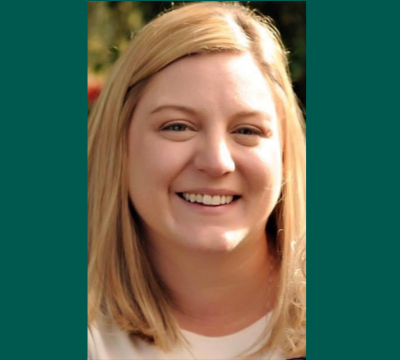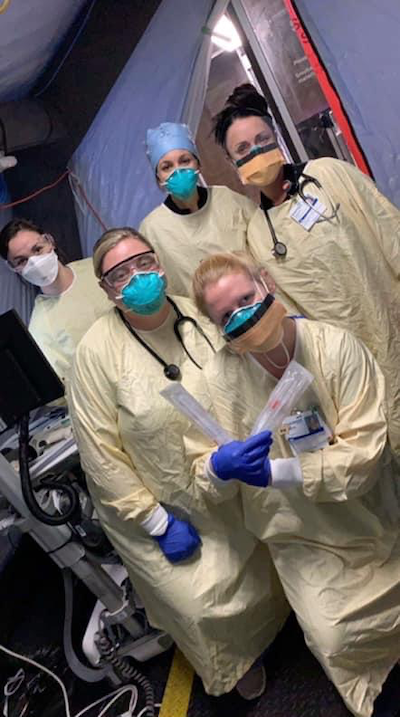A marathon at sprint pace: Physician Assistant Studies alum Katherine Bechard reflects on COVID care
By Katherine Bechard, MS '18
A pandemic is a hard thing to comprehend until you have lived through one. We all learned about pandemics during our training, of course, and maybe even tried to envision what it must have been like to provide care during one. If I am being honest, that is how I thought of it - in the past tense. I also believed if one should one occur, our level of knowledge, our technology, and our contingency plans would have us better prepared to readily combat such an occurrence than those of the past.

COVID-19 quickly changed those thoughts to present tense as my team and I suddenly found ourselves in the midst of an overwhelmed emergency department.
In the winter of 2020, I was working at a small community hospital near Detroit. A novel virus wreaking havoc on the other side of the globe started making headlines that were certainly alarming, but I had hope that it would not spread.
I saw a patient weeks before the pandemic took hold in Detroit - before we knew what COVID looked like or had it on the differential - who was found to have bilateral multilobar pneumonia. At the time, that finding in a young, otherwise healthy patient was uncommon; it was the first of innumerable chest X-rays I would look at with those findings. I took a family vacation in February with little hesitation, not knowing that just a few weeks later I would consider moving out of my home to protect my family from my exposures working in emergency medicine.
While much of the country was just developing an idea of what was to come, Detroit was suddenly inundated with COVID-19. My small community hospital was in the thick of it seemingly overnight, and we had to adapt rapidly.
The triage area was turned into a COVID ward. When that quickly became insufficient space, the ED set up a trailer in the parking lot. We did triage and limited exams while standing outside patient vehicles to quickly determine if they needed further evaluation inside the ED or if they could safely be sent home with return precautions. These cars were often packed with several ill family members. With very limited supplies, we could only test those who were ill enough to require hospitalization. The worried well were upset about not getting tested, while the truly ill were sometimes afraid to go inside. Our resuscitation rooms were perpetually full, and it often felt like we were one breath away from being unable to provide potentially lifesaving care.
Our training to work as part of a collaborative environment within all specialties made PAs a critical and respected part of this effort.
We had relatives coming in at the same time. In one example of this, my colleague saw one, I saw the other, and we met in the hallway outside their rooms as we quickly walked to the resus bays to get each of our patients moved to a room with the capability to provide critical care. They were intubated in neighboring bays, one shortly after the other, as their more stable relative was evaluated in a nearby room. This is one of several particularly memorable moments the pandemic has left me with.
During this time, protocols changed rapidly. I became accustomed to walking into a shift after 12 hours off and asking what the working policies of the day were so far. All providers worked as a team to quickly identify what was not working, what was, sharing ideas to improve care and efficiency, and implementing them in short order.

Our training to work as part of a collaborative environment within all specialties made PAs a critical and respected part of this effort. As providers from other specialties were redistributed due to their normal services being nearly stopped, we had help from PAs from all backgrounds in the ED. We formed a team bonded by this extreme environment, and most were willing to help however they could, whether it meant doing H&Ps [history and physical exams] outdoors in snow and rain, getting vitals in the triage car line, or making copies of the information packets we could not print enough of. We came together as a community, with no job too big or too small.
After the initial surge slowed, patient volumes dropped. The abdominal pain, chest pain and injuries that are typical in the ED were simply not coming in. The first laceration repair I did in months was a refreshing glimpse into some normalcy - until the patient shared he sustained the laceration during a coughing fit and tested positive for COVID.
Slowly, the emergency department has gotten closer to normal, with chief concerns that run the gamut returning, plus an occasional COVID surge. Sometimes this feels like a marathon run at a sprint pace; as soon as you catch your breath, it's time to hit the ground running (while donning PPE) again.
Volumes have returned plus some, with current record volumes in the ED at the academic institution where I now work. The Delta variant combined with kids returning to school has me on edge, as the pediatric ED I split my time in is already boarding patients most days.
While this weighs heavily on my mind and the reality of a pandemic will always live very much in the present tense for me now, this experience has also shown me the resilience and capability of my fellow PAs. It has made me a better and more well-prepared provider for whatever may come my way. I certainly hope that will never be another pandemic, but if it is, PAs will always be at the ready to help lead the response.
The Physician Assistant Studies master of science degree program at the Wayne State University Eugene Applebaum College of Pharmacy and Health Sciences is focused on the development of highly competent and passionate physician assistants who are deeply committed to practicing in urban and underserved health care settings.
This story appeared in the Fall 2021 Physician Assistant Studies alumni newsletter. Read the full issue for more program news.